SHEMETOV YEVGENY. STUDIES OF PHASE TRANSITIONS IN THE UNITED A2BX4 STRUCTURE β-K2SO4 METHOD NUCLEAR QUADRUPOLE RESONANCE
English abstract § 1.1 § 1.2 §1.3 § 1.4 § 2.1 § 2.2 §2.3 §2.4 § 3.1 § 3.2 § 3.3 § 3.4 § 4.1 § 4.2 § 4.3 § 4.4 Reference Template pdf abstract -download
RUSSIAN ACADEMY OF SCIENCES Institute of Chemical Physics. Semenov
A manuscript UDC 536,913,405 +539.89
Shemetov V. Yevgeny
Investigation of the sequence of phase transitions in compounds with the structure A2BX4 β-K2SO4 NQR halogens at atmospheric and high pressure.
01.04.07. - Solid state physics
Author's abstract.
thesis for the degree of Candidate of Physical and Mathematical Sciences
Moscow 1995
Work performed at the Institute of Physics SB RAS. L.V.Kirenskogo Krasnoyarsk branch of the Republican and Technology Center of the Russian government.
Supervisor Candidate of physico-mathematical sciences MOSKALEV AK
Opponents: Dr. tehnicheskin, Professor T.A.Babushkina; Candidate of Sciences matematicheskik D.L.Zagorsky.
Lead Institute of Organoelement Compounds, AN Nesmeyanova
Thesis held ____ 1995, at ___ hours ___ minutes. At a meeting of the Specialized Council D002-26.04. at the Institute of Chemical Physics. N.I.Semenova RAS address: 117334, Moscow, ul. Kosygin 4.
With the thesis can be found in the library of the Institute of Chemical Physics
sent to 1995.
Scientific Secretary of the Specialized Council Ph.D., professor V.Ya.Rochev
Study of phase transitions in compounds such A2BX4 STRUCTURE β-K2SO4 NQR halogens at high and atmospheric pressure.
General characteristics of the work.
Relevance of the topic.
Method of nuclear quadrupole resonance (NQR) is widely used as a method to study the structure of substances including the phase transitions in crystals. Recently, a special place in such studies has been paid partially disordered state, one of the classes which are dielectric crystals with a structure of β-K2SO4, were unearthed disproportionate (Inc) phase. Under disproportionate means special structural state of the crystal, which is formed by the interaction of crystalline functions with differing periods. Theoretical models disproportionate state in dielectrics show that the period of the structure of the dipoles can be both multiple and non-multiple grating period of the original high-temperature phase. When converting to the low-symmetric phase, the ordering depending on the nature of atomic interactions may be effected in various ways. On the one hand through a series of long-period phase states by transformations of the first kind, and the other, a continuous way: according to the actual change of the wave vector qδ, corresponding to the minimum mode (or the maximum coupling constants) responsible for the stepwise behavior, called simple devil's staircase 'Devil `s Starcase», was recorded and investigated in magnets. After opening the disproportionate state dielectrics diffraction. radiospectroscopic and experimental data indicated the importance of continuous change qδ.
By the beginning of our studies and, there were only a few compounds A2BX4, from the family of β-K2SO4, where it was possible to detect incommensurate phases and study them in detail. Due to the fact that the NQR method is very sensitive to the gradient of the intracrystalline electric fields, its use for research disproportionate state in the dipole system is not in doubt. However, when initially applying it to this class of crystals detected very weak signals of radio frequency absorption mainly in the low temperature region of the incommensurate phase. In this regard, the intermediate objective was to increase the sensitivity of the method, from which depended the success of the study compounds with β-K2SO4 type and finds in them a thorough study of incommensurate phases.
Objective.
Study of nuclear quadrupole resonance of halogens (Cl, Br, J), and other methods, the family of crystals with β-K2SO4 structural disproportion. Elucidation of changes in the spectral features of the resonance parameters in phase transitions; Analysis investigated the local environment of the nuclei, and its transformation into compounds of the series when the high temperature and hydrostatic pressure. Study processes of spin dynamics in combination with other methods of analysis of the crystal symmetry changes at structural phase transitions.
New scientific results.
First NQR using the methods of X-ray diffraction, calorimetry, electro-optics and dielectric measurements studied sequence of transitions in the compounds Cs2CdJ4, Cs2ZnJ4. and (NH)2ZnJ4 with an incommensurate phase.
The spatial point symmetry groups and commensurate phases.
In compounds Rb2ZnBr4 , Cs2ZnJ4 and found two polymorphs α and β. While β-modification, where realized sequence of phase transitions with incommensurate structure is unsustainable and stabilization of metastable conditions, such as moisture, becomes α-modification.
In a first for Cs2ZnJ4 А2ВX4 family connections with cesium cation registered full range 127J NQR frequency scale throughout the incommensurate phase below Ti. Before TC found wide temperature range before ordering transition. Change NQR spectrum in this area can be interpreted in terms of phase transitions with clusters predecessors.
In β-Rb2ZnBr4 updated temperature frequency dependence of the NQR spectrum 79,81Br at atmospheric pressure and obtained navye data. Established that the phase transition at Ti decreases fluctuations before the first race. At low temperatures, the incommensurate phase at TC, along with the basic structure according to a tripling of the unit cell of the crystal (qδ ~1/3), in the form of the NQR spectrum indicated a different structure. In studies under a pressure established that the latter refers to the state of the crystal, characterized wavevector qδ~1/4 and the other branch fashion ∑ . 79,81Br NQR under high pressure is detected and investigated in detail the sequence of highly symmetric and disproportionate-ordered phases in β-Rb2ZnBr4. The phase P-T diagram in the region of 170-3600K at pressures up to 1 GPa. Recorded sequence of phase transitions in the Inc P-T field Rb2ZnBr4, interpreted in the framework of the "'devil's staircase." Analysis of transformation of the NQR spectrum indicates that the low temperature portion of the incommensurate phase observed behavior of the type simple stairs (complete D'S), and in the medium temperature is possible mixed (incomplete) view "satanic stairs" A comparison-with the theoretical phase diagrams of pseudo-spin model with phonon coupling.
Scientific and practical value.
1. Realizovany Methods and devices that increase the sensitivity of pulsed NQR spectrometer for the purpose of detection of weak signals of radio frequency absorption and precision temperature measurements under high hydrostatic pressure.
2. Construct a high pressure, which is used with a standard NQR spectrometer in the study of the structural features of the phase transitions in disordered crystalline systems,
3. New experimental data on the structure transformation in compounds with symmetry Pnma A2BX4 temperature changes. Not detected previously observed phase transitions,
4. NQR built P-T phase diagram of β-Rb2ZnBr4. Existing data can be used to construct a molecular model of the transformation of the family structure in the compounds β-K2SO4,
5. First, in some connection A2BX4, revealed the existence of another polymorph - α. We propose to search for new members of the family A2BX4 with a metastable structure type β-K2SO4
6. The spin-spin and spin-lattice relaxation of nuclei halogen NQR incommensurate phases. Shown that the new level of quality research is necessary to extend the lower range of equipment for temporary permission microsecond limit.
7. NQR analysis of spectral data indicated the need to revise the previously accepted model to describe the shape of the resonance lines in the incommensurate phases.
Personal contribution of the author.
Developed and implemented a device for temperature and hydrostatic pressure vysokog research. Synthesized compounds Cs2ZnJ4 and (NH) 2ZnJ4. Conducted all the experimental NQR measurements and their analysis. Developed and used applications for numerical simulation of the NQR line shape in the modulated phases. The author participated in the preparation and implementation of other experimental studies of teaching and learning, supported by research quadrupole resonance.
Testing work.
The main part of the dissertation presented and discussed at the All-Union scientific conferences:
-on rf, Kazan, 1984.
-on the physics of ferroelectrics: Chernivtsi, 1986., Rostov-on-Don, 1989.;
- International conferences and symposia; -XI conference MAVRID .. High Pressure Science and Technology. Kiev. 1987.:
-X Symposium on NQR, Takayama, Japan, 1989.;
Crystallographic-European conferences:
XI-Poznan (Poland), 1987. , XII-Moskva, 1989.; Symposium - Sat 23rd Congress Ampere, Novosibirsk Shushenskoe 198g.;
-IV Japan-Soviet Symposium on ferroelectrics, 1988;
-7th Symposium on ferroelectricity Sarbryuker, Germany, 1989;
-Soviet-Polish seminar on ferroelectrics, Lvov, 1990;
-XII Symposium on NQR, Zurich, Switzerland, 1993.
Publications: On the topic of the dissertation is published 22 print jobs.
Structure and scope of work:
The work consists of an introduction, four chapters, conclusions, list of references of 135 titles.
Dissertation presented in 172 pages of text, 5 tables and 70 figures.
• HIGHLIGHTS OF WORK.
Introduction. The place of research topics in the general range of problems in solid state physics. The features of dielectric crystals, where the first place stands the ordering of chemical bonds via dipole-dipole interaction. Is the objective of research.
Chapter 1.
Disproportionately - modulated phases in dielectrics with a structure of β-K2SO4.
A brief overview of the theory of phase transitions in the concept of the soft mode and Ising models, taking into account for the nearest neighbors interaction cluster picture of phase transitions of the displacement type and order-disorder.
The theoretical principles of the NQR method and its application to the study of critical phenomena and phase transitions. Presented a phenomenological model of the line shape of the nuclear quadrupole resonance in the plane-wave approximation and the soliton. The theoretical data on the processes of nuclear relaxation in the incommensurate phase.
Discussed the experimental data on the study at atmospheric pressure A2BX4 compounds with tetrahedral coordination of the anions and the high-temperature phase with the space group Pnma: Rb2ZnJ4, Cs2HgBr4 and others.
Given P-T phase diagram. investigated in dielectric crystals of various experimental methods. At the end of an overview chapter summarizes the state of research in dielectrics structure β-K2SO4, and formulated the problem of work.
CHAPTER 2. Equipment and measurement technique.
2.1 equiv ... remote sensor NQR and conditions optimum adaptation to the measuring chamber. The ways to increase the sensitivity of pulse NQR experiments in conditions of prolonged tracking of temperature and pressure dependences. As follows from the dissertation in electrodynamic calculations, signal to noise ratio (SN) radio spectrometer increases with radius r and length l of the receiving sensor, r * as the square root of l. However, there is an optimal ratio between the size of the sensor and the internal dimensions of the measurement chamber, in which a balance is achieved between the reduction in the ratio of SN, because of the inductive-capacitive coupling and receiving radio frequency measurement and hardware circuits, and an increase in SN due to increased take-up spool. Taking account of this and the use of suitable materials design allows ultimately increase the sensitivity of the method. The fruitfulness of this approach was confirmed after manufacturing thermal tops and high-pressure cells for measuring weak signals in the 35Cl NQR K2ZnCl4, where the author of the absorption line not to register earlier.
2.2. Temperature consoles to the spectrometer ISSH research phase transitions. Set out details of the construction of thermo-gradient-top boxes for the study of phase transitions NQR. The basic idea underlying the action of liquid thermal camera is a replacement for liquid gas environment, providing better heat transfer properties. The design of this thermal camera was not realized by the author based on the standard thermo-top box to the spectrometer ISSH. As coolants used N-pentane (a liquid-state 138-3080K), hexane, high oil (Ткип <6000C). With vigorous stirring, the temperature gradient in the fluid volume measuring chamber out (with an accuracy of ±0.010K/sm).
Due to the fact that the storage of liquids at room temperature with a melting point <1100K requires special measures that impede the use of liquid thermal cameras below these temperatures was developed another design that has a heat transfer fluid circulation mode and can be used in an embodiment of the gas conditioning. The design of this camera is significantly different from the presentation. In a liquid coolant mixing mode is carried Circulator. To equalize the gradients at the gas conditioning (blowing), a system of grids and channels contributing self-mixing hydrodynamic gas streams. In this case the temperature gradient on the sample was 0.01-0.020K/mm.
Distance of the sensor to the NQR solderless socket sensor NQR spectrometer and using the principles of optimal maTChing possible to increase the ratio of SN to 10 times.
2.3. Synthesis of samples made in A2BX4 labopatory crystallophysics Institute of Physics SB RAS, and I.T.Kokov, V.A.Grankina based on chemical АX and ВX2 as Bridgman method from the melt and from aqueous solutions.
Connection of A2BX4 type structure β-K2SO4 usually crystallized in the form of single-crystal plate splices sizes up to 40mm and a thickness of 5mm. Some samples, to remove impurities, two; recrystallized three times. Before NQR measurements and samples were ground in a thin-walled container placed in NQR sensor. Been tested influence operations preconditioning on the measurement results, and found that the samples grown and (or) inhomogeneously deformed in the temperature range of the incommensurate phase have different spectral characteristics in comparison with the samples or are born in the high-temperature phase. Detailed information on this, the example Rb2ZnBr4 given in paragraph 4.1 of the dissertation,
2.4. Apparatus for NQR studies under high hydrostatic pressure. Described, created with the direct participation of the author and requires the highest level of the experiment, setting the research in atmospheric and high hydrostatic pressure P-T phase diagrams and critical behavior near singular P-T states of crystals. Instrumental complex includes NQR pulse spectrometer ISSH1-13 (Made in the USSR) , electronic assembly changes, control and maintain the temperature and pressure, high-pressure apparatus (multiplier, pumping station, a high-pressure bomb) or thermo-console , precision graphic recorder.
Particular attention is paid to the design of the dissertation high-pressure chambers (HPC) for studies at low temperatures. One of them - HPC1 having a lumen diameter of 16mm, allowed to observe NQR signals at pressures up to 1.5 GPa, Seal performed indentation chopper with a set of rings on the chamfer channel bomb. This design allows you to work with the sample to 3sm3 has radiospectroscopic sensitivity and a half orders of magnitude lower than the standard dimensions and is designed for intensive observation NQR signals. Another cell (HPC2) specially developed by the author for registration absorption signals from quadrupolar nuclei in incommensurate phases at pressures up to 400MPa. Diameter of the channel, where the coil NQR increased to 40mm. Construction of the obturator and seal have fundamental differences from the standard and are to reduce its axial size; increasing the diameter of the channel under electric high voltage input; in the hydraulic seal cavity bombs flattening bronze ring of triangular section. To reduce RFI (Radio Frequency Interference) and delinking conductors and high frequency P-T sensors, the latter is supplied through an additional seal. This design has achieved the conditions of observation NQR signals approximate to standard conditions.
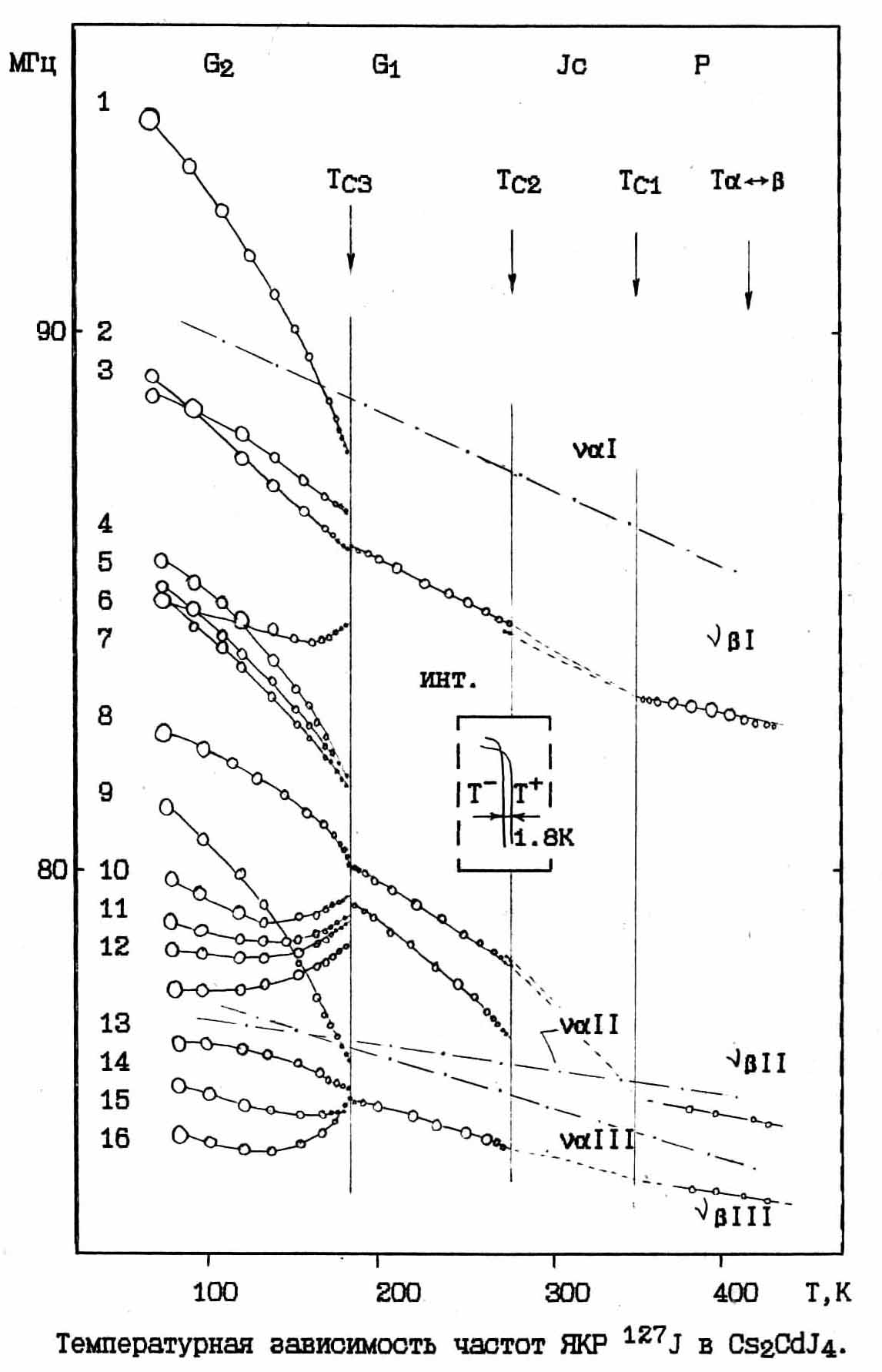
Chapter 3. Sequence of phase transitions in compounds A2BX4 (X = J). Experimental data on the study of phase transitions in compounds not previously studied A2BX4 NQR: Cs2CdJ4 (CCJ), Cs2ZnJ4 (CZJ) and (NH4)2ZnJ4 (AZJ).
3.1. Phase transitions in Cs2CdJ4. In 1986, by NQR method in Cs2CdJ4 author found two modifications - α and β. Modification of α is stable in conditions of high humidity and changes in β modification by drying the crystal, for example, after heating the sample in vacuum above 100OC When thermally induced α ↔ β transition, there is no reduction of the sample weight and absent (with an accuracy of ~ 2%) NMR signals from protons associated crystal. On this basis, it is concluded that the α-phase is the phase of the polymorphic compounds β a metastable phase, since in the presence of atmospheric moisture rapidly into α modification.
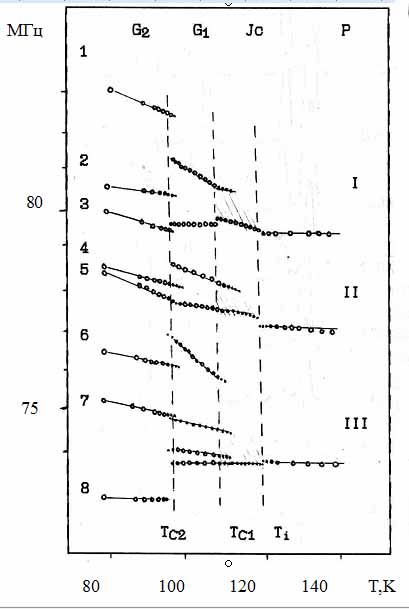
In Cs2CdJ4 NQR in the range 420¸770K found three phase transitions at TC1=335; TC2=260 and T C3 = 1840K with changes multiplicity range from three to four lines of equal intensity 16 (Fig. l). In the temperature range 335 ¸ 2600K absorption recorded in the narrow neighborhood before TC2, where the view of the spectrum typical for Inc phase. As was explained, the absence of signals due to the fact that the spin-spin TQ2 and spin- lattice TQ1 relaxation are below the resolution limit of the temporary pulse spectrometer (ТQ < 10-8s). Below TC2 is fixed below 4 absorption signal abruptly transforming at TC3 in 16 singlet NQR lines. In this case the temperature dependence of the frequency, critical slowing TQ1 and phase coexistence ~ 20K clearly indicates close to the tricritical point phase transition at T C3. Multidisciplinary studies involving methods calorimetry, electro-optics and X-ray diffraction allowed to establish a framework for the transformation of β-modified tetra-iodo- cadmiat cesium
Pnma (Z=4) ↔ Jc ↔ P21/n (Z=4) ↔ ![]() (Z=8)
(Z=8)
Fig. 2. Temperature dependence of the NQR frequencies 127J Cs2ZnJ4.
In the incommensurate phase detected X-ray satellites in the position qδ ≈0.24¸0.25a*. Symmetry of α-modification identified by us as P21/m (Z=2). A relaxation of the NQR data indicate the nature of its slow spin dynamics (Т Q1 ≥ l ms; ТQ2 ≈ 200µks) with respect to the β-phase.
3.2. Investigation of the sequence of phase transitions in Cs2ZnJ4.
In CZJ change the multiplicity of the spectrum of the complex spectrum through three to eight, and again to eight lines, and the temperature dependence of the frequency quadrupole transition 1/2 ↔ 3/2 isotope 127J observed three phase transitions at Ti = 118; TС1 =108, and TС2 =950K (Fig. 2). In the temperature range 118¸1080K throughout the frequency scale for the first time with cesium cation of compounds A2XB4 registered NQR spectrum of the detected author of the incommensurate phase. With the use of complementary techniques were established symmetry phases: Pnma(Z=4) ↔ Jc, qδ = (1+d)a*/2 ↔ P21/n(Z=8) ↔ P1 (Z=4), and X-ray studies recorded below Ti satellite reflections with the value qδ ≈ 0.15a* at T = 1120K.
According to the quadrupole transition 1/2↔3/2 times the temperature dependence tracked T Q1 and T Q2 in 380-770K from all cores 127J nonequivalent positions structure Pnma.
Feature relaxation characteristics CZI is a distinct two-scale character associated with structural features. In a wide temperature range ~1000K before Ti signals recorded as the decay of free precession and asymmetric inhomogeneous broadening of the spin-echo signals nuclear response. Changes in the relative intensity of the longitudinal and transverse contributions absorption and asymmetry last indicates abnormal change in the nature of atomic motions at 3200K, below which develop cluster-type fluctuations structure of the incommensurate phase.
.
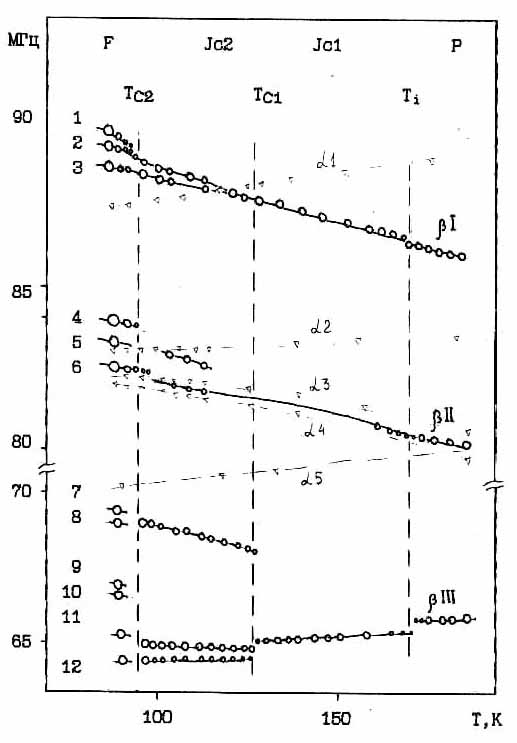
3.3. NQR study of phase transitions in (NH4)2ZnJ4.
Author first synthesized and studied by NQR 127J compound (NH4)2ZnJ4. In the temperature range 77-4000K found three phase transitions at Тi=1650К, ТС1 = 1260K and ТС2= 870K (Fig. 3).
Above Ti observed three intense absorption line (1/2 ↔ 3/2) with the character of the dependence Bayer ν(T). When Ti marked decrease in the intensity of lines and race frequencies. Shape of the spectrum, fixed below T C1 indicates disparity observed structure. Below TC1 multiplicity spectrum changes to seven broadened lines are not of equal intensity, and at the boiling point of nitrogen absorption signals recorded 12 NQR. Stroke frequency ν(T), intensities, and shapes NQR signals are comparable with those observed in Rb2ZnCl4 and Rb2ZnBr4, confirms the assumption that the author of symmetry transformation in tetra-iodo ammonium zincate under the scheme:
D2hl6(Pnma) ↔ Inc1 ↔ Inc2 ↔ C2v9(Pn21a) ,
while the phase between 125 and 870K may be interpreted as incommensurate rather arbitrary and is rather long-periodic (qd ≈ 2/7) with symmetry Pn21a. Noted the existence of another structure of the compound with the same observation conditions for modifying α - Cs2CdJ4.
Fig. 3. Temperature dependence of the frequency of the NQR spectrum (NH4)2ZnJ4.
At the end of the third chapter of the comparison data for NQR А2ВHа14 compounds, which exhibit phase Inc. The greatest amount of frequency decoupling DnI-III , noted for ammonium compounds (31%) and the smallest for cesium (up 7%). It is poorly explained from the viewpoint of crystal chemical relationships, because radii of the cations NH4 and Cs are close in value, and indicates significant chemical (electronic) contribution to the nature of this splitting. Temperature dependence of ν(T) below Ti unusual and poorly explained by known types of molecular motions. Significant line widths in the initial phases Inc and at extremely short time values TQ1 and TQ2 indicate structural dynamic disordering of the molecular fragments. Largest ΔνI-III and especially in the form of components nI celebrated a special position compound Cs2ZnJ4.
Significant impact on the correctness of the nuclear dynamics registering frequency spectral characteristics NQR involves revising the phenomenological model describing the shape of the resonance line Inc phases.
Comparison of the data with the results of NQR spectroscopy in other crystal systems (with charge density waves, one-dimensional organic conductors, octahedral crystals with Jahn-Teller complexes) allows to plan a way to explain the data NQR through electron-nuclear movements in the two-scale timeline.
3.4. Polymorphism in the family A2BX4. After the discovery of the author in 1986. α-polymorphic modifications Cs2CdJ4 and later Rb2ZnBr4, K2ZnBr4 etс. , with symmetry group P21/m and the establishment of the fact that in these compounds is metastable β-form, the question arises about the generality of this phenomenon in the family A2BX4. The classification of compounds A2BX4 on experimentally known for their space groups: Pnma and P21/m and the method of implementation of the structure type β-K2SO4 in other compounds of the family.
On the basis of experimental data the mechanism of the α↔β transition: through surface orientation ordering β structure to α, the dipoles of water molecules. The reverse process is carried out by removing traces of water and thermal induction of metastable modification with the accelerated nature of the spin dynamics.
At the end of this section discusses the cause of the observed phenomena in terms of mathematical theory for systems with long-range interatomic interactions.
Chapter 4. Sequence of phase transitions in Rb2ZnBr4 at atmospheric and high hydrostatic pressure. The results of studies of phase transitions in tetrabromzincates rubidium NQR. High pressure is a factor that allows to obtain fundamentally new information on the transformation of the structure in the compounds A2BX4.
4.1. 79,81Br absorption spectra in the incommensurate phase at atmospheric pressure.
At the initial stage of the study in Rb2ZnBr4 using NQR found: 1) the dependence of signal intensity on the number of cycles in the cooling phase, Inc; 2) that the majority of freshly grown or present during wet (≈ 50%) atmosphere crystals are fully or partially, or are moving to another structure with symmetry P21/m. Conditions for its stabilization and transition to the metastable β-modification with an incommensurate phase completely analogous α ↔ β transformation in Cs2CdJ4 and differs only significantly longer duration of α ↔ β process; 3) induction of non-hydrostatic stress, residual growth and thermal stresses nonequilibrium state structure β-Rb2ZnBr4, disappearing after annealing.
Precision study of the temperature dependence of the NQR frequencies Rb2ZnBr4 in Ti transition at 1 atm revealed races frequency spectral lines from Br nuclei in positions II and III structure Pnma, as well as unusual splitting frequency spectrum component Тi in the incommensurate phase. On these grounds it has been found that a phase transition at a Ti close to first-order. In the transition to the ferroelectric phase F was registered racing frequencies and additional absorption lines not previously observed. The complex shape of the spectrum was numerically explained: 1) manifestation in the crystal structure of another type (different from the symmetry of the soft mode S submission) or another branch (except S2) symmetry; 2) the coexistence of multiple modulation sequences of "devil's staircase." To clarify these issues, the study was used at high pressure.
4.2. P-T phase diagram Rb2ZnBr4.
In the first part of this section examines the structure of the phase P-T diagram RZB obtained using HPC1. In this first tracked P-T region existence paraelectric (P), F , Inc phases and detected symmetrical high-pressure phase G and H (Fig. 5). The multiplicity of the NQR spectrum of twelve F-phase lines, through a complex range of intermediate N-phase and four to fourteen powerful singlet phase lines H and G, respectively (Fig. 4). A detailed study of the transformations of the NQR lines isotopes 81Br and 79Br in the incommensurate phase performed using bombs HPC2.
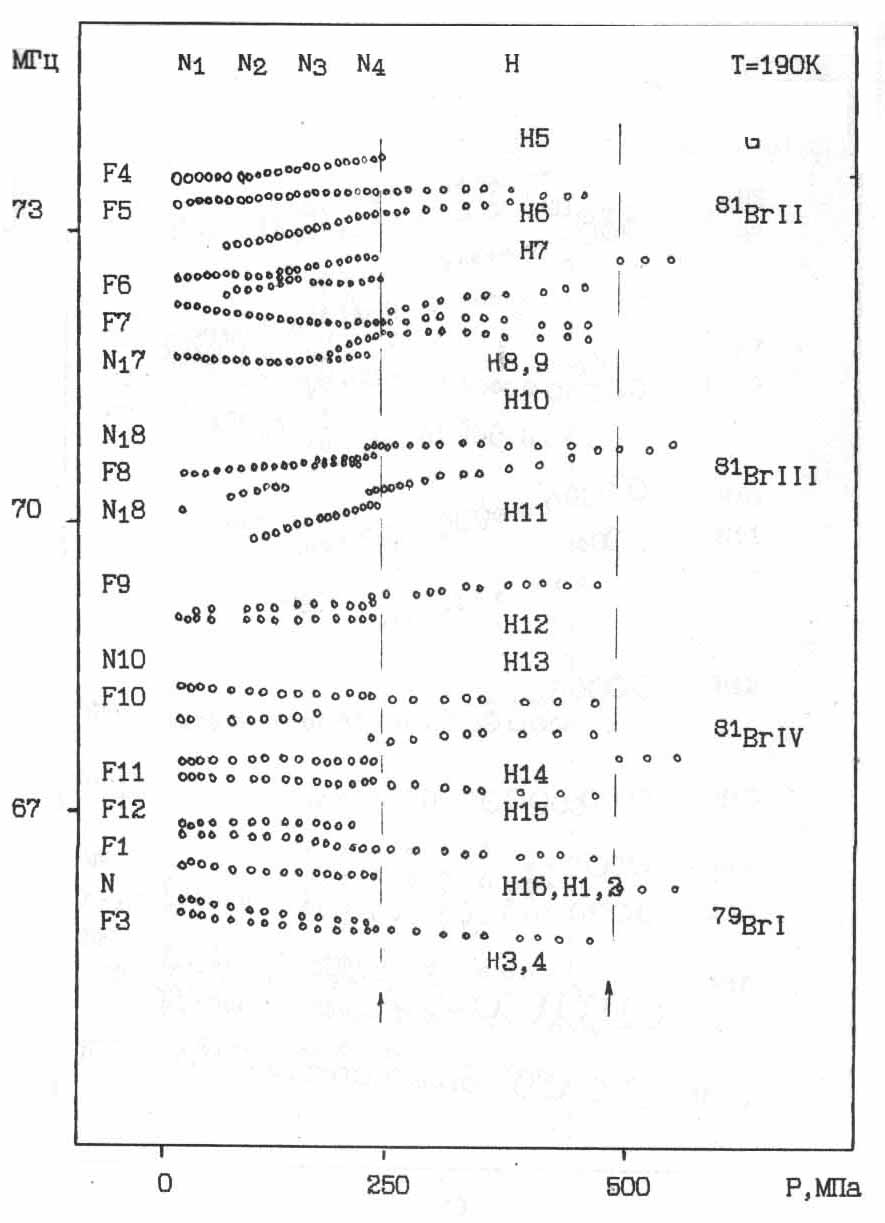
Fig. 4. Baric move 81Br NQR frequencies in Rb2ZnBr4.
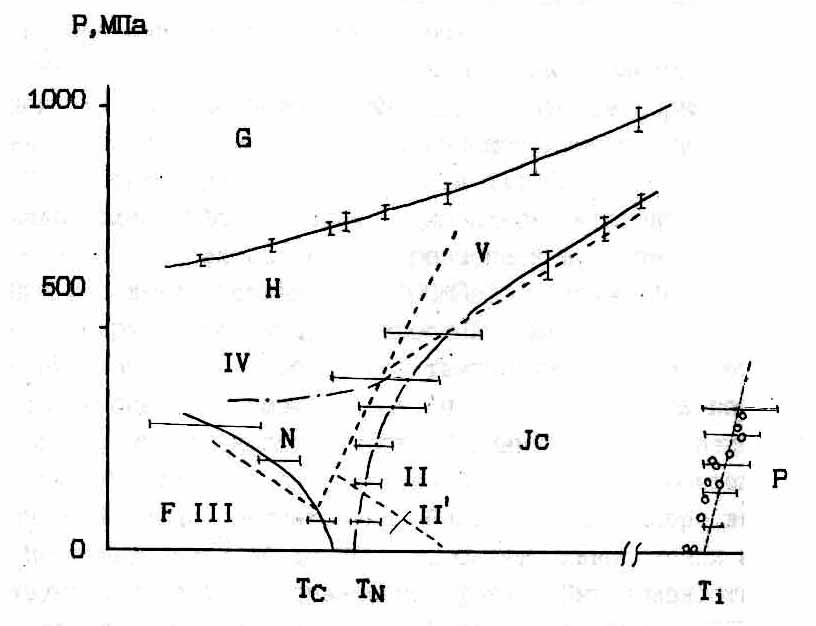
Fig. 5. Rb2ZnBr4 phase diagram according to the NQR.
20 iso-thermal and isobaric P-T sections, in which high-resolution spectra were recorded from all NQR nonequivalent positions 81Br , scanned the temperature and pressure dependences of the frequency ν(P, T), the intensities I (P, T) and linewidths Dn(P).. Tracked items transformation spectra of phase F through N to H phase, and in the middle region of the incommensurate phase through a sequence of disordered phases Inc↔М1 ↔ М2 ↔ М3 to G phase. On the anomalies in the dependencies ν(P), I(P), Δν(P) P-T installed P-T lines of phase transitions. All of these transitions have the first order with the values of the pressure hysteresis DР from 20 to 160MPa, and DР increases with increase decreasing T and decrease P, and essentially depends on the direction of change of P-T parameters. Changing pressure phase transition temperature of the paraelectric phase to the incommensurate obtained involving DTA method.
4.3. Features transformations spectrum near ТC. Comparison with the diffraction data.
Considered parts of a complex transformation of the NQR spectrum and analyzed its performance in the low P-T region N incommensurate phase near ТC, where we assume a step change in the structure. Analysis of non-monotonic changes in the intensities and spectral distributions of asymmetry possible to detect characteristic mild anomalies between different structurally related states N1, N2, N3, N4 modulated phase. In an embodiment of the NQR data interpretation in the framework of "devil's staircase" structure Nj correspond to states with different values of a step change in the wave vector qδ, and observed P-T overlapping area. This interpretation was confirmed by NQR active on the same samples by neutron diffraction in the international scientific center of Orsay (France). Satellites have been detected, the values of a* in units which can be placed on an upward steps of (5/17 → 3/10 → 7/23 → 1/3) and down (3/10 → 8/27→ 5/17→ 7/24→ 2/7→ 1/4 ) of stairs. At this pressure the following sequence of transforming the structure β-Rb2ZnBr4. Fig. 6.
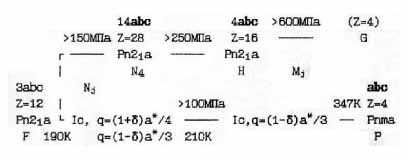
4.4. Discussion The phase diagram in the framework of the "devil's staircase."
A comparison of the experimental phase P-T diagram RZB with the theoretical phase diagrams "Ds" S» and found that phase Inc М1, М2, М3, meet stepwise reduction of the vector qδ when approaching a Lifshitz point.
At the end of paragraph NQR data discussed based on the theory of the existence of Baka random phase is an intrinsic property of systems with frustrating interactions. In this case, incommensurate phases with wave vectors, for example, qδ≈1/4+d и qδ≈1/3 can have different states with topologically overlapped structure, different phase shift. On the basis of this comparison indicated that in the M phase diagram observed smoothed (incomplete) mode "Ds" S ", in Inc - classical (smooth), and N region close to the step (complete) behavior.
Based on this discussion, involving the analysis of solutions φ-model, which is applicable to describe compounds A2BX4 with β-form elements proposed model explaining changes in the structure Rb2ZnBr4 no diffraction data and microwave spectroscopy.
In concluding the discussion, based on research conducted by the author, analyzed the experimental data on the temperature change of the wave vector of all known at the time of writing the work, A2BX4 compounds with the structure of β-K2SO4, and proposed a generalized P-T diagram predicts the possible phase diagrams of these crystals. While cesium compound was isolated subclass, characterized by a particular sequence of symmetry transformations associated with the softening of the phonon spectrum near G point of the Brillouin zone, and the rest - in the subclass - S along the line.
MAIN RESULTS the operation.
1. NQR for precision studies of phase transitions created gradientless thermo-consoles and high-pressure chamber having an optimal agreement with the receiving part of the standard quadrupole resonance spectrometer.
2. Studied the sequence of phase transitions in Cs2CdJ4. First detected NQR incommensurate phase in β-modification of the crystal.
Complementary experimental methods given scheme symmetry changes. X-ray diffraction analysis confirmed the presence of the incommensurate phase.
3. The sequence of phase transitions in the crystal Cs2ZnJ4. NQR 127J registered incommensurate phase, found a wide temperature range subtransient ordering. The assumption is made and confirmed the change of symmetry in phase transitions in this compound.
4. Measurements TQ1 and TQ2 wide range of temperatures show a significant effect of halogen nuclear spin relaxation on the shape of the NQR lines in the incommensurate phase.
5. Аuthor synthesized and studied by NQR compound (NH4)2ZnJ4. Nuclear quadrupole absorption between levels 1/2↔3/2 isotope 127J found three phase transitions crystal structure. Form lines and features of the temperature behavior of the frequency suggests that the intermediate phase in β-crystal state are disproportionate.
6. Polymorphic modifications crystal Rb2ZnBr4 and Cs2CdJ4 α↔β . Found that β -modification in compounds Cs2CdJ4 and Rb2ZnBr4 is metast able. The conditions for the implementation of transition.
7. Method of nuclear quadrupole resonance investigated P-T phase diagram Rb2ZnBr4. Revealed two high-symmetry phase high pressure. Change in the spectra in the intermediate P-T field indicates a step change of the wave vector, which is consistent with the diffraction measurements, and does not contradict the theoretical pseudo-spin model of incommensurate phases.
Publications on the topic of the dissertation.
1. Serebrennikov VL No Comments EV Belobrova IA Investigation NQR incommensurate and commensurate phases in Rb2ZnCl4 ,Rb2ZnBr4 and under pressure; Union Conference on Magnetic Resonance in Condensed cpedah, Kazan, Abstracts, Part 1, 1984.
2. Aleksandrova IP, No Comments EV. Serebrennikov VL, New effects in NQR spectra disproportionate Rb2ZnBr4, XI All-Union Conference on the physics of ferroelectrics, Chernivtsi, abstracts v.2, page 157-B, Kiev, 1986.,
3. Aleksandrova IP, No Comments EV Serebrennikov B. L., Research P-T phase diagram Rb2ZnBr4 NQR; X1 MAVRID International Conference, Kiev, 1987, theses B24, p.20-21,
4. Aleksandrova IP, No Comments EV Serebrennikov VL,, neighborhood study ferroelectric phase transition in Rb2ZnBr4 NQR under high pressure, Phys, 1987, v.29, 9, 2651-57.
5. Shemetov E.V., Aleksandrov K.S..Aleksandrova I.P.,Primak S.V., The 1Z7J NQR study of the phase transition in Cs2CdJ4., Xth Ampere summer school, Abstracts, Novosibirsk, 1987, p.247.
6. Aleksandrov K.S., Flerov I.N., Kruglik A. I., Melmkova S., Shemetov E.V., Phase transitions in Cs2CdJ4 crystal. XI Europress meeting on ferroelectricity, Poland, 1987, Abstracts n-i.p.99.
7. Shemetov E.V., Aleksandrov K.S., Aleksandrova I.P., Primak S.V. 1Z7J NQR study of the phase transition sequence In Cs2CdJ4, Phys.Stat.Sol.(a), 1987, v.104, p.K89-92.
8. Aleksandrov K.S., Flerov I.N., Kokov I.Т., Kruglik A.I., Melnlkova S.V., Shemetov E.V., Successive phase transitions in Cs2CdJ4 crystal, Ferroelectrics, 1988, v.79, p. 137-140.
9. Aleksandrova I.P., Shemetov E.V., Serebrennikov V.L., Primak S.V., Pressure-Temperature Phase Diagram of Rb2ZnBr4; IV Japan-Soviet symposium on ferroelectricity, 1988, Abstracts.
10. Shemetov E.V., Aleksandrova I.P., Primak S.V., J-127 NQR Study of Phase Transition in Cs2CdJ4 and Cs2ZnJ4; Xth International Symposium on NQR, Takayma, Japan, 1989, Abstracts, III , P2.
11. Shemetov E.V., Aleksandrova I.P., Primak S.V., J-127 NQR Study of Phase Transition in Cs2CdJ4 and Cs2ZnJ4; Xth International Symposium on NQR, Takayma, Japan, 1989, Abstracts , III , P2.
12. Aleksandrova I.P., Shemetov E.V., Serebrennikov V.L., Pressure-Temperature Phase Diagram of Incommensurate Rb2ZnBr4, XII-th European Crystallografisal Meeting, Moscow, 1989, Abstracts.
13. Aleksandrova I.P..Shemetov E.V,,Primak S.V., Krugiik A.I., Sucoesive phase transitions in Cs2CdJ4 and Cs2ZnJ4, 12th European Crystallographies meeting, Moscow, 1989, v.l, p.526.
14. Aleksandrova I.P., Shemetov E.V., Serebrennikov V.L., High Pressuren Sience and Technology, Procedings XI AIRAPT International Conference, Kiev, Naukovs Dumka, 1989,v.1 p. 208-211 , A Study of Phase P-T Diagram of Rb2ZnBr4 by NQR Mettod.
15. Aleksandrova IP, No Comments EV, SV Primak, Kruglic AI, Study of phase transitions in Cs2ZnJ4 and Cs2CdJ4, XII All-Union Conference on the Physics of Ferroelectrics, Rostov / Don, 1989, v.1 , p.123.
16. Aleksandrova IP, No Comments EV Serebrennikov V.L., Research proportionate and incommensurate phases Rb2ZnBr4 NQR under pressure, XII All-Union Conference on the Physics of Ferroelectrics, Rostov-Don, 1989, Vol.1, pp. 122.
17. Aleksandrova I.P., Prlmak S.V., Shemetov E.V. ,Krusrlik Successive phase transition in Cs2CdI4 and Cs2ZnI4. 7th International Meeting of Ferroelectricity, Saarhruoker, Germany,1989, Abstracts, P139.
18. Aleksandrova IP Primak NE., Elizariev Y.G . Denovue F. Kruglic AI, No Comments E.V., incommensurate phase in the crystal Cs2ZnJ4, Soviet-Polish seminar on ferroelectricity, Lviv, 1990, Proceedings, pp. 219-220.
19. Aleksandrova I.P., Primak S.V., Shemetov E.V., Krugiik A.I., Elizaryev Yu. G., Successive phase transitions in Cs2CdJ4 and Cs2ZnJ4. Ferroelectrics, 1990, v.105, p.177-181
20. Aleksandrova I.P., S.V. Primak, No Comments EV Kruglic AI sequence of phase transitions in Cs2ZnJ4, FTT, 1991, v.33, 5, str.1344-1349..
21. Semin G.K., Shemetov E.V., Moskalev А.К., 127J NQR Study of phase Transitions in (NH4)aZnJ4, XII th International Symposiym on NQR Spectroscopy, Zurich, Shwezerland, 1993, Abstracts.
22. Shemetov E.V., Moskalev A.K., Semin G.K., Pressure-Ntmperature Phase Diagram of Rb2ZnBr4 by 81,79Br NQR Method, XII th International Symposiym on NQR Spectroscopy, Zurich, Shwezerland, 1993, Abstracts.